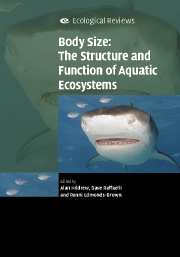Book contents
- Frontmatter
- Contents
- List of contributors
- Preface
- 1 The metabolic theory of ecology and the role of body size in marine and freshwater ecosystems
- 2 Body size and suspension feeding
- 3 Life histories and body size
- 4 Relationship between biomass turnover and body size for stream communities
- 5 Body size in streams: macroinvertebrate community size composition along natural and human-induced environmental gradients
- 6 Body size and predatory interactions in freshwaters: scaling from individuals to communities
- 7 Body size and trophic cascades in lakes
- 8 Body size and scale invariance: multifractals in invertebrate communities
- 9 Body size and biogeography
- 10 By wind, wings or water: body size, dispersal and range size in aquatic invertebrates
- 11 Body size and diversity in marine systems
- 12 Interplay between individual growth and population feedbacks shapes body-size distributions
- 13 The consequences of body size in model microbial ecosystems
- 14 Body size, exploitation and conservation of marine organisms
- 15 How body size mediates the role of animals in nutrient cycling in aquatic ecosystems
- 16 Body sizes in food chains of animal predators and parasites
- 17 Body size in aquatic ecology: important, but not the whole story
- Index
- References
4 - Relationship between biomass turnover and body size for stream communities
Published online by Cambridge University Press: 02 December 2009
- Frontmatter
- Contents
- List of contributors
- Preface
- 1 The metabolic theory of ecology and the role of body size in marine and freshwater ecosystems
- 2 Body size and suspension feeding
- 3 Life histories and body size
- 4 Relationship between biomass turnover and body size for stream communities
- 5 Body size in streams: macroinvertebrate community size composition along natural and human-induced environmental gradients
- 6 Body size and predatory interactions in freshwaters: scaling from individuals to communities
- 7 Body size and trophic cascades in lakes
- 8 Body size and scale invariance: multifractals in invertebrate communities
- 9 Body size and biogeography
- 10 By wind, wings or water: body size, dispersal and range size in aquatic invertebrates
- 11 Body size and diversity in marine systems
- 12 Interplay between individual growth and population feedbacks shapes body-size distributions
- 13 The consequences of body size in model microbial ecosystems
- 14 Body size, exploitation and conservation of marine organisms
- 15 How body size mediates the role of animals in nutrient cycling in aquatic ecosystems
- 16 Body sizes in food chains of animal predators and parasites
- 17 Body size in aquatic ecology: important, but not the whole story
- Index
- References
Summary
Introduction
A crucial requirement for the analysis of energy flow through freshwater food webs is the accurate and precise estimation of secondary production (Benke et al., 1988). The rate of production (or biomass-turnover rate) is often expressed as either annual production-to-biomass ratios (annual P/B) or daily biomass-growth rates (g, Appendix I). Invertebrate production and annual P/Bs have now been estimated on a taxon-specific basis for a relatively wide range of freshwater habitats, streams and rivers in particular, and often this has been done within a community context (see reviews by Benke, 1993 and Huryn & Wallace, 2000).
The relationships between body size and either daily or annual P/B for freshwater invertebrates have been assessed using empirical approaches (Banse & Mosher, 1980; Plante & Downing, 1989; Morin & Bourassa, 1992; Benke, 1993; Morin & Dumont, 1994). The results of such studies provide strong evidence that annual P/B is negatively related to body size (Appendix I; Fig. 4.10). However, recent efforts showing remarkably high P/Bs for some benthic macroinvertebrates in both warm-water (e.g. Benke, 1998; reviewed by Huryn & Wallace, 2000) and cool-water streams (e.g. Nolte & Hoffman, 1992) suggest that the results of these early studies – Banse and Mosher's (1980) still widely cited analysis, for example – greatly underestimate biomass turnover. Furthermore, because they are based on meta-analytical approaches incorporating comparison of populations taken from many different communities, these earlier studies do not allow the analysis of factors constraining patterns of P/B as a function of the body size of individual taxa within single communities.
- Type
- Chapter
- Information
- Publisher: Cambridge University PressPrint publication year: 2007
References
- 26
- Cited by

